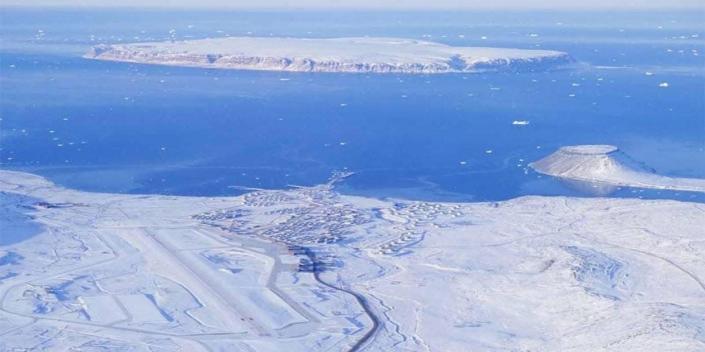
-
The US and Canada are modernizing NORAD to watch for Russian, Chinese, and North Korean missiles.
-
To really improve its coverage, NORAD should expand to include Greenland, two researchers say.
-
That kind of integration could benefit each country’s security, but there are complicating factors.
During the Cold War, the North American Aerospace Defense Command was guardian against nuclear annihilation and a reminder that such annihilation was only one order away.
After the demise of the Soviet Union, NORAD’s star waned, but as China, Russia, and North Korea field more advanced ballistic, cruise, and eventually hypersonic missiles, North America faces a growing threat that seems like a reprise of the Cold War.
As a result, NORAD is getting more attention in the form of technological modernization. At the same time, some experts argue that the command should expand beyond North America to include Denmark and its North American territory, Greenland.
‘Greater and more complex’ threats


The US and Canada founded the North American Air Defense Command in 1958 in response to fears that Soviet bombers — and later ICBMs — would arrive over the North Pole and devastate the North American heartland.
By the early 1960s, NORAD comprised a quarter-million personnel and an elaborate system of radars, missile-warning satellites, command centers, jet interceptors, and anti-aircraft missiles.
NORAD’s reach grew throughout the Cold War. The threat of Soviet submarine-launched missiles and fractional orbit bombardment systems, which would approach from the south rather than the north, led to the command taking on a global remit.
The development of space-based weapons prompted a name change in 1981. North American Aerospace Defense Command, as it’s now known, is also responsible for detecting and tracking North Korean missile launches.
“Canada and the United States have long benefited from the protection afforded by North American geography,” US Secretary of Defense Lloyd Austin and Canadian Defense Minister Harjit Sajjan said in August 2021. “However, growing strategic competition, rapid advancements in technology, and ongoing changes in our climate are eroding that protection, including by exposing North America to a greater and more complex conventional missile threat.”


The US and Canada, which jointly run NORAD, pledged to replace the aging North Warning Network — a chain of air-defense radars across the far north of the US, Canada, and Greenland — with next-generation, long-range over-the-horizon radar.
The countries also agreed to embrace a comprehensive “system-of-systems approach” that included a network of sensors “from the sea floor to outer space” and more integrated command-and-control systems.
But the North Pole is still a dagger pointed at North America.
“Since the shortest airborne routes from Russian, Chinese, or North Korean territory to North America transit Arctic and sub-Arctic areas, those more directly northern routes have always been particularly important to NORAD,” RAND Corporation researchers Michael Bohnert and Scott Savitz wrote in a recent commentary.
Bohnert and Savitz also offer a provocative argument: make Denmark a member of NORAD, turning it into a tri-national organization.
It wouldn’t be much of an expansion. As the two researchers point out, Greenland is a part of North America and the US has long maintained early-warning radar stations there to detect missiles and bombers coming over the Arctic.


“From a military perspective, Greenland dominates the northeastern approaches to the continent,” Bohnert and Savitz write. “NORAD nations have long recognized the criticality of Greenland, which hosts a U.S. airbase in Thule, as well as various smaller facilities and radars.”
Politically, Greenland is a part of Denmark, which complicates matters.
“U.S. military operations in Greenland are overseen by the U.S. European Command (EUCOM), rather than the U.S. North American Command,” write Bohnert and Savitz, noting that the current status reflects Greenland’s importance to EUCOM as a vantage point to monitor Russian ships and submarines sailing between the Arctic and North Atlantic oceans.
But formal integration with NORAD and forces in North America “could enable greater resource sharing, enhancing the early-warning capabilities of the United States and Canada while providing Danish forces with expanded access to NORAD data,” the researchers write. “This could improve the security of all three nations, without requiring additional forces or bases.”
Arctic intrigue


Still, there are some complicating factors.
Denmark is a European nation with its own security interests distinct from North America, and Greenland is a self-governing country within the Kingdom of Denmark, though the Danish government retains control in some areas, including defense and foreign affairs. Copenhagen also rebuffed the Trump administration’s overtures about acquiring the territory in 2019.
Some Greenlanders want full independence, however. Could interest in NORAD expansion embroil the US in Danish domestic politics? Bohnert thinks this is unlikely to be a problem.
“Integration of Denmark via Greenland into NORAD would give the US and Canada direct engagement with both Danish and Greenlandic authorities,” he told Insider. “Regardless of any domestic decisions, this structure would provide a vehicle to maintain continuity.”
In any event, the importance of the Arctic is growing. Melting Arctic ice has spurred multiple countries — including Russia and China — to eye newly accessible mineral resources and shipping routes, and military activity there is increasing. The defense of North America is still on NORAD’s radar.
Michael Peck is a defense writer whose work has appeared in Forbes, Defense News, Foreign Policy magazine, and other publications. He holds a master’s in political science. Follow him on Twitter and LinkedIn.
Read the original article on Business Insider




